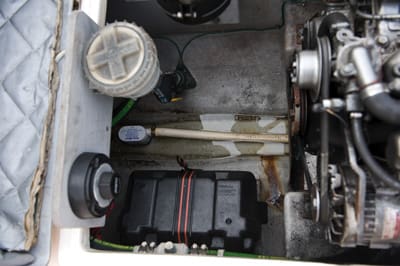It’s a fact of boating life, oil and diesel fuel will find its way to the bilge. Methods for getting this oily water out of the bilge range from a sponge and a bucket to absorbent pads to the use of microorganisms that “eat” the oil and convert it onto less objectionable materials. Two of these companies are Clean Water Solutions of Newport, R.I., and Bio-Sok from Hampshire in the U.K.
When it comes to this bio-attack approach, there is a new product that harnesses a mysterious “third domain” of life. Clean Water Solutions offers a line of products based on the microorganisms from the domain called Archaea. These tiny critters can convert oil and other objectionable chemicals into a harmless material that can even be eaten by fish.
Scientists currently shoehorn all life on earth into three domains: 1. Eucaryotes (which, just as you’d guess, includes plants, animals, humans, fungi and slime molds), 2. Bacteria (everything from spirochetes to thermotoga and aquifex — don’t worry, I don’t know what that means, either) and 3. Archaea, tiny organisms that the average person would have a hard time differentiating from bacteria.
It seems that these microscopic, single-celled Archeae are very similar to bacteria, but differ in some important ways (well, important to biologists, anyway). These include their evolutionary history and their biochemistry. Another difference that makes Archaea unique is the materials they can use for food, such as metals, ammonia, hydrogen gas, and, of course, hydrocarbons like diesel fuel and engine oil. Its this ability to eat hydrocarbons — which includes a long list of chemicals such as MTBE, nitrates, benzene, cyanide, vegetable oil, even animal feces and fish blood — that makes these diminutive Archaea so useful.
Given the right combination of water, oxygen, temperature and motion, the Archaea in Clean Water Solutions’ products will go wild on hydrocarbons in your bilge. At the end of the digestion process, the “waste” produced by Archaea is fatty acids. According to Clean Water Solutions, these nonhazardous lipids can be safely disposed of — you could even feed them to your fish.
Clean Water Solutions uses a mixture of 100 different strains of Archaea in its products. Mixed in with a clay-based carrier, the Archaea lie dormant until conditions are right, then they multiply every 20 minutes and live for 90 days. According to Susan Homer, CEO of Clean Water Solutions, these microorganisms are not the result of tinkering in the lab. “They are not genetically modified,” Homer said. “They are naturally occurring strains found throughout the world.”
Clean Water Solutions offers their Archaea in a variety of packages. For boat owners looking to clean up a messy bilge, the most likely product appears to be their Oil Eradicator series. These combine the Archaea microbes with a sponge-like foam carrier. The unit floats in your bilge for months, consuming oil. At the end of the summer, you can throw the foam unit into the trash with no worries about oil contamination. These Oil Eradicators come in a variety of sizes based on boat length. Clean Water has another product called MicroTabs. These are small packages of a clay/Archaea mixture that can be dropped into a sewage-holding tank. The Archaea consume the nasty items in the holding tanks, especially odorous items like ammonia that make holding tanks so unpleasant.
Another company that uses microorganisms to clean up oily bilge water is British-based Bio-Sok in Hampshire. Bio-Sok operates a bit differently than the Clean Water Solutions products, however. The primary ingredient in Bio-Sok is a petroleum remediation product (PRP), a type of modified beeswax that floats and holds oil and hydrocarbons within its wax matrix. Microorganisms are attracted to the PRP and then break down the hydrocarbons. After roughly 30 days, the microorganisms attracted to the Bio-Sok PRP will have run their course and the Bio-Sok unit can be safely disposed.
These and other products cleverly make use of microorganisms to fight the natural propensity of oil to find its way into the bilge.

